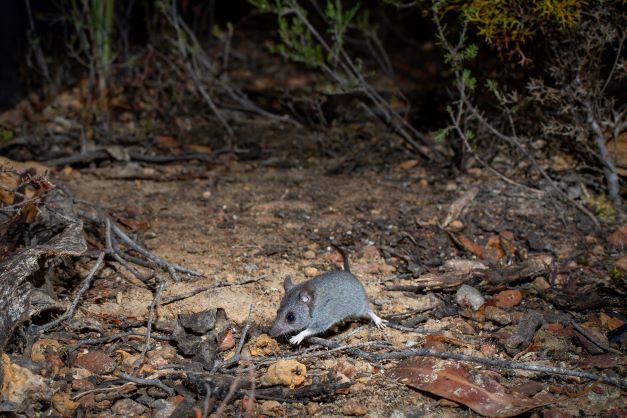A small carnivorous marsupial found nowhere else on earth, the Kangaroo Island Dunnart was facing imminent extinction after losing more than 95 per cent of its habitat to bushfire during the 2019-20 Black Summer bushfires.
Taking swift action, AWC joined forces with local landholders and conservation organisation, Kangaroo Island Land for Wildlife (KILfW), to help protect the remaining population, creating a 13.8-hectare critical refuge around an area of unburnt habitat where the dunnarts had been detected.
 Brad Leue
Brad Leue
AWC Photographer, Brad Leue, captured the above image within this critical refuge just days after the devastating fires.
He used a DSLR camera trap system of his own making, and the incredible shot took seven nights to achieve – adjusting focus, lighting, and camera positions to target the animal’s regular movements.
Finding hope after devastation
 Brad Leue
Brad Leue
“It was pretty grim when first arriving on Kangaroo Island after the summer bushfires of 2019/20. Smoke was still in the air, burnt trees still with smouldering embers and the Australian Defence Force patrolling the roads. The community was shaken, exhausted, but together and full of hope,” explains Brad.
“From our end, it was all hands –on deck, working with our partners Kangaroo Island Land for Wildlife to track down and protect any remaining KI Dunnart populations that were at threat from feral cat predation. With a lot of the landscape torched by extreme fire, resembling that of a moon scape, we were concerned that populations had diminished — and in the hope that a few individuals had made it through, we were certain they would be picked off by feral cats without immediate intervention.
Kangaroo Island Dunnarts are about the size of a House –Mouse. They are a carnivorous marsupial; a cousin of species like the Quoll and Tasmanian devil. The summer 2019/20 bushfires burnt 210,606 hectares (approximately half) of Kangaroo Island, and up to 95 per cent of the Kangaroo Island Dunnart’s known range, making them one of the top predicted species to become extinct in the following 20 years.
Within a small patch of unburnt vegetation, trail cameras were deployed and to our relief, a small population of Kangaroo Island Dunnart were detected in the area. Cat trappers were deployed and in record time, AWC, KILFW, local landholders, and the Australian Defence Force banded together to erect predator-proof fencing around the susceptible population, creating what is now known as the Western River Refuge.
My job as a photojournalist was to document the work and attempt to obtain imagery of the threatened Kangaroo Island Dunnart to help generate awareness and support for the species and the work being done to aid in their survival.”
Setting up the shot
 Brad Leue
Brad Leue
“I spent ten nights in the area, monitoring a network of trail cameras within the unburnt vegetation to recognise behavioural patterns or frequently used ‘runways’ that may help me capture an image of the species. Within a small patch of banksia scrub and grass tree thickets, we were detecting 1 or 2 individuals on somewhat of a two-day cycle. I chose this location to focus my attention,” says Brad.
“Working with such a small, elusive species that only emerges after dark, I chose a camera trap setup as my approach. This comprises of a DSLR camera which is connected to an IR sensor that commands the camera to fire when movement is detected. Lighting and flash units can be incorporated into the setup when targeting nocturnal subjects or shooting video.
One thing I’ve learnt over the years about DSLR camera trapping is to keep expectations low. It’s a hard game; predicting the correct focus point of your subject… the correct lighting structure, moisture on the lens, false triggers. Or the worst result – just a limb of your subject in the frame. You can prepare and research for months, but there is a lot of room for error when walking away from your gear in the bush with crossed fingers.”
The first shot
 Brad Leue
Brad Leue
“On night four, I captured my first KI Dunnart image. Far from perfect but encouraging – a basis for what was working and what wasn’t. I regrouped and altered the setup accordingly and the following night was rewarded with some lovely shots, from a somewhat wide perspective showing both the animal and habitat. After a few successful nights shooting wide with a 50mm lens, I upped the challenge and tried for close-detailed shots with a 100mm macro lens. All the challenges regarding focus are exacerbated with the macro lens, so I was not too confident, but after a few more nights and 658 duds, we ended up with five nice macro shots that showed the species in beautiful detail.”
Ongoing recovery
 Brad Leue
Brad Leue
Over the last couple of years, Kangaroo Island’s landscape has begun its recovery. The Western River Refuge has now been extended to include a 369-hectare predator-proof safe haven which supports a healthy population of Kangaroo Island Dunnarts, as well as other threatened and unique species to Kangaroo Island, including the Southern Brown Bandicoot, Heath Goanna and Kangaroo Island Echidna.
“My images were used to bring awareness to the plight of the Kangaroo Island Dunnart and to help gain support and funding to aid in the species survival. They were used in various TV and media publications, including The Australian, Australian Geographic, and National and International Broadcast News,” says Brad.
“It was a devastating time for the community of Kangaroo Island but their camaraderie and hope was truly beautiful to see. This will always be one of my most memorable shoots.”
Support Australian Wildlife Conservancy's science-led conservation work and safeguard the future of Australia's native species
Donate Now